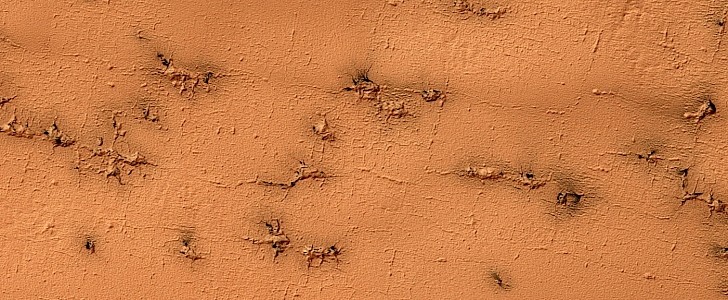Imagine how much of a big deal it would be for us humans to discover life on Mars. Not some trace of an ancient form of it, but life that exists today, even in the form of microbes, or some nasty insect.
Despite many years of trying, we so far have failed to find any life there. Sure, there are hints it may have existed in some form in the past, but to say for certain that we do know Mars had/has life, that’s something we cannot do.
But we can imagine stuff, thanks to the tens of thousands of images of the planet at our disposal, the quirkiness of many of the planet’s features, and pareidolia, that tendency of the human brain of seeing familiar shapes where there are none.
As we move deeper into the world of HiRISE orbital images of Mars, it becomes increasingly obvious that’ll probably take a lot of time before we get used to the fact that what we see there is not something we know from here on Earth.
Take this image, snapped by the orbital camera back in 2016, and recently made public by the University of Arizona. It shows a portion of the planet’s South Pole region, covered in something scientists call “rectangles with wiggly sides.”
To our eyes, they may look like spiders or, even better, a small army of fire ants, but they are in fact polygonal patterns bounded by short straight channels, created by the sublimation of the dry ice seasonal polar cap, and the subsequent rise to the surface of local dirt.
In the case of this exact region, we’re told “escaping carbon dioxide gas has exploited these channels and in the process, deepened them and added sinuosity to the formerly straight segments.”
So, we’re hard at work trying to locate traces of life on Mars, but until we do, at least we have these images to ignite our imagination as to what life away from our planet might look like.
But we can imagine stuff, thanks to the tens of thousands of images of the planet at our disposal, the quirkiness of many of the planet’s features, and pareidolia, that tendency of the human brain of seeing familiar shapes where there are none.
As we move deeper into the world of HiRISE orbital images of Mars, it becomes increasingly obvious that’ll probably take a lot of time before we get used to the fact that what we see there is not something we know from here on Earth.
Take this image, snapped by the orbital camera back in 2016, and recently made public by the University of Arizona. It shows a portion of the planet’s South Pole region, covered in something scientists call “rectangles with wiggly sides.”
To our eyes, they may look like spiders or, even better, a small army of fire ants, but they are in fact polygonal patterns bounded by short straight channels, created by the sublimation of the dry ice seasonal polar cap, and the subsequent rise to the surface of local dirt.
In the case of this exact region, we’re told “escaping carbon dioxide gas has exploited these channels and in the process, deepened them and added sinuosity to the formerly straight segments.”
So, we’re hard at work trying to locate traces of life on Mars, but until we do, at least we have these images to ignite our imagination as to what life away from our planet might look like.






